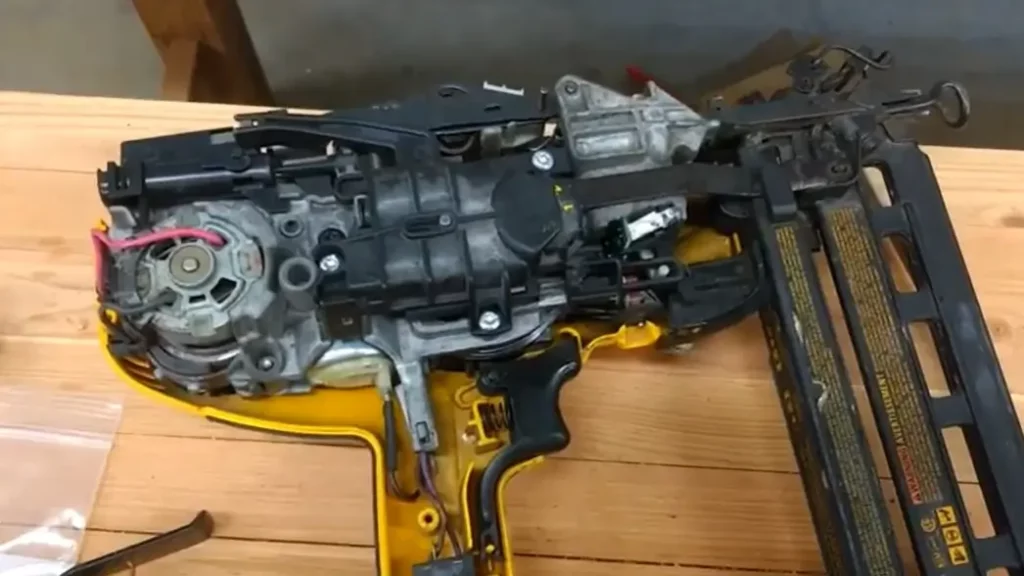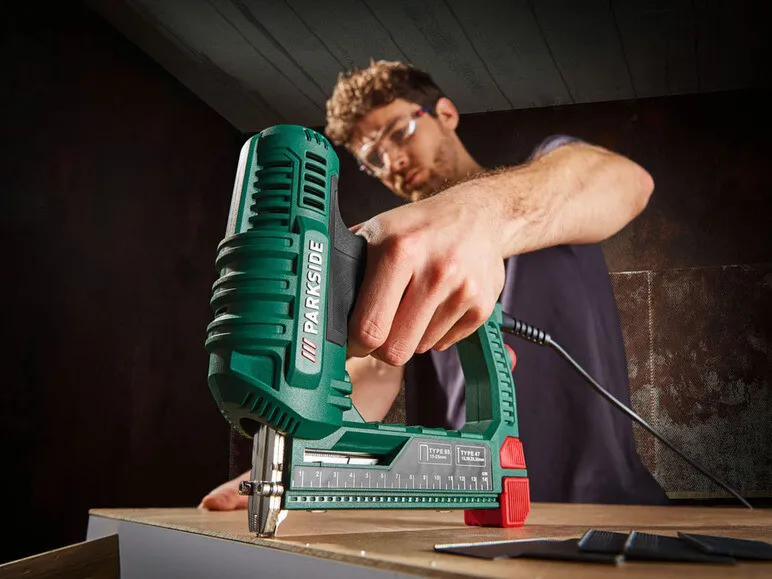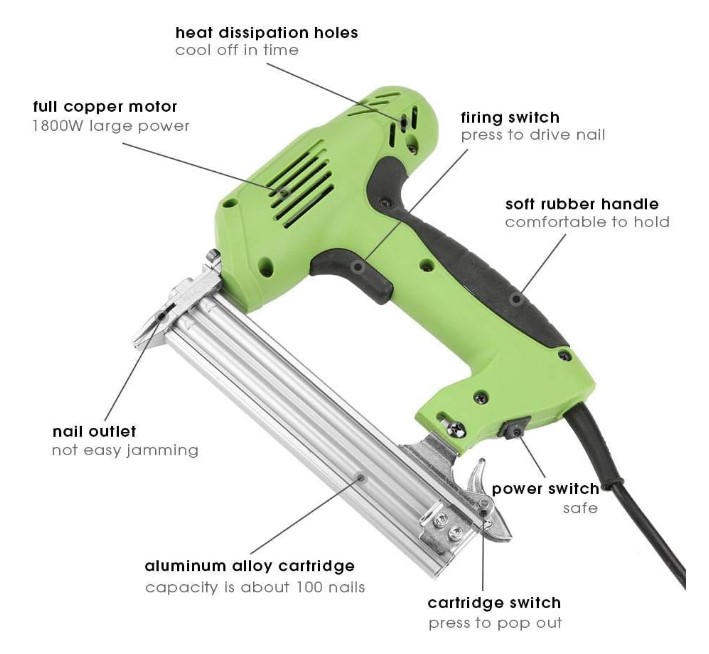An electric nail gun works by using an electrical current to generate force that propels a nail into a surface. The gun has a motor that powers a piston, which compresses air that forces the nail through the gun’s tip.
These tools are designed to replace traditional hammers and make it faster and easier to complete jobs that require nailing. They’re commonly used by construction workers, woodworkers, and DIY enthusiasts for framing, finishing, and crafting. Electric nail guns come in different sizes and types, with each designed to fit specific purposes.
This article delves into the inner workings of electric nail guns, unraveling the technology that propels nails effortlessly into surfaces.
So, let’s join us on a journey through the mechanics and applications of these modern marvels that have redefined the art of fastening.

What Is An Electric Nail Gun?
An electric nail gun is a tool that uses electricity to power the driving mechanism, which propels nails into different materials. A motorized piston is responsible for driving nails into surfaces such as wood or drywall.
Compared to a manual nail gun, electric nail guns offer a quicker and more efficient way to drive nails into surfaces.
These tools are commonly used in construction and woodworking for tasks such as framing, installing baseboards, or securing trim.
They also offer a faster and more precise alternative to manual nail driving, increasing efficiency and reducing the physical effort required for large-scale projects.

Types Of Electric Nail Guns
There are two types of electric nail guns: corded and cordless. Corded nail guns operate via a power cord that must be connected to an electrical outlet.
Cordless nail guns, on the other hand, are battery powered and do not require a power cord.
Cordless nail guns offer greater mobility, while corded nail guns offer increased power and unlimited use.
Advantages Of Electric Nail Guns Over Pneumatic Nail Guns
Electric nail guns offer several advantages over pneumatic nail guns. Some of these advantages include:
- More mobility: Cordless electric nail guns allow for greater flexibility and maneuverability on job sites, particularly in remote or outdoor locations without access to electrical outlets.
- More user-friendly: Electric nail guns are easy to use and require minimal manual labor to operate.
- Less maintenance: Unlike pneumatic nail guns that require the use and maintenance of an air compressor, electric nail guns only require the occasional battery charge or power supply.
- More power: Corded electric nail guns offer greater power and speed than pneumatic nail guns, meaning they can drive nails through tougher surfaces with greater ease.
- Less noise: Electric nail guns are quieter than pneumatic nail guns, making them ideal for indoor or residential projects where noise levels need to be kept low.
What Are Some Drawbacks To Electric Operated Nailers?
While electric nail guns offer numerous advantages, they also come with certain drawbacks. Here are some considerations:
- Power Dependency: Electric nail guns require a power source, either through a cord connected to an outlet or a rechargeable battery. This dependency can be limiting in situations where power access is challenging or unavailable.
- Limited Portability: Corded electric nail guns are tethered to an electrical outlet, restricting their mobility. Although cordless models provide more flexibility, they are still limited by the battery’s runtime, requiring periodic recharging.
- Weight and Size: Some electric nail guns, especially those with built-in motors and batteries, can be heavier and bulkier compared to manual or pneumatic nailers. This may impact user comfort during extended use.
- Initial Cost: Electric nail guns often have a higher upfront cost compared to manual counterparts. While this cost may be offset by increased efficiency and reduced labor, it’s a factor to consider when budgeting for tools.
- Limited Power for Heavy-Duty Tasks: Electric nail guns may not be as powerful as pneumatic nailers, especially for heavy-duty applications like framing. Pneumatic tools often provide higher driving forces for larger nails and tougher materials.
- Battery Life Concerns: Cordless electric nail guns rely on rechargeable batteries, and their performance may decline over time. Users might experience reduced battery life and performance as the battery ages.
Despite these drawbacks, electric nail guns remain popular due to their convenience, ease of use, and suitability for a wide range of applications.
Components Of An Electric Nail Gun
An electric nail gun is a power tool that drives nails into wood or other materials. It is efficient, fast and can save time if you have many nails to drive.
It’s important to understand how an electric nail gun works, so let’s take a closer look at the components of an electric nail gun.

Main Components
1. Motor
The motor is the power source of the electric nail gun. It provides the force to drive nails into the material. The motor has a coil of wire that creates a magnetic field, which then moves a piston that drives the nail.
2. Trigger
The trigger is the switch that activates the motor, and it’s located near the handle of the nail gun. When the trigger is squeezed, it sends an electrical signal to the motor to start.
3. Magazine
The magazine is the component that holds the nails before they are driven into the material. It’s located on the top of the nail gun and can usually hold up to 100 nails.
4. Battery
The battery provides the power to the motor that drives the nail. Most electric nail guns come with a rechargeable lithium-ion battery that provides reliable power, so you don’t need to worry about operating the tool with cords and wires.
5. Circuit Board
The circuit board is the component that controls the motor and its functions. It regulates the power to the motor and controls the speed of the nail gun.
Secondary Components
6. Safety Mechanism
The safety mechanism is an essential component that prevents accidental firing of the nail gun. It’s located on the nose of the tool and needs to be depressed before the gun can shoot any nails.
7. Depth Adjustment
The depth adjustment mechanism allows you to control how deep the nail guns the nail into the material. This is especially important when working with different types of wood, as you need to adjust the depth to prevent the nail from sticking out or going too far inside.
8. LED Light
An led light is an optional component that helps to illuminate the area where you’re working. It can be essential when working in poorly lit areas and can be turned off when needed to conserve the battery.
Understanding the components of an electric nail gun is crucial to ensure that the tool operates correctly and safely. With this knowledge, you can get the most out of your nail gun and complete your projects with ease.
Working Mechanism Of An Electric Nail Gun
Electric nail guns pack a powerful punch without the need for heavy-duty compressors or explosive cartridges. But how do these handy tools transform electricity into nail-driving magic? Let’s dive into the mechanics:
Power Supply
The electric nail gun is powered by electricity. Most of them plug into wall sockets, while others use rechargeable batteries. When activated, the power supply sends an electrical impulse to the motor.
Motor And Gear Assembly
The motor and gear assembly are the heart of the electric nail gun. The motor converts electrical energy into mechanical energy to power the gear assembly. The gear assembly, in turn, amplifies the motor’s power, creating rotational energy to drive the nails.
Motor Function
When the power supply sends an electrical impulse to the motor, the motor’s electromagnet is activated, creating a magnetic field. The magnetic field spins the rotor inside the motor, which powers the gear assembly.
Gear Assembly Function
The gear assembly amplifies the motor’s power, creating rotating energy that drives the nails. The mechanism increases the force of the nail gun’s linear motion by transforming the high-speed motor movement into slow, powerful strokes that drive the nail head.
Nailing Mechanism
The nailing mechanism varies depending on the electric nail gun model. Some models use gas to fire the nail, while others rely on electric current. In either case, a piston propels the nail out of the gun and into the target surface.
Trigger Function
The trigger is the user input that activates the electric nail gun’s motor. By pressing the trigger, the user starts the motor, which drives the nails into the surface.
Nail Magazine Function
The nail magazine is the component that stores the nails in the electric nail gun. The magazine’s position on the gun depends on the model, and some magazines hold more nails than others. Once the magazine is loaded, the nails are automatically fed into the nailing mechanism.
Safety First
While electric nail guns are convenient and powerful, remember safety is paramount. Always wear safety glasses and gloves when operating the tool. Keep your fingers away from the trigger and barrel, and ensure the gun is pointed in a safe direction. Refer to the manufacturer’s instructions for specific safety guidelines and proper operation techniques.
An electric nail gun has a simple yet efficient working mechanism. Understanding how it works helps users to make the most of the nail gun.
Now that you know how it works, you can use this tool more efficiently in your carpentry, woodworking, or construction work.
Do Electric Nail Guns Need Gas?
No, electric nail guns do not require gas. Unlike some types of nail guns, such as gas-powered or pneumatic (air-powered) models, electric nail guns operate solely on electricity.
They are either corded, requiring a power outlet, or cordless, powered by rechargeable batteries.
The electric motor in these nail guns generates the force needed to drive the nails into the material. This eliminates the need for external power sources like gas cartridges or compressed air tanks, making electric nail guns a convenient and portable option for various applications in construction and woodworking.
Do Electric Nail Guns Need Oil?
Unlike pneumatic nail guns, electric nail guns typically do not require oil for operation. Pneumatic nailers rely on compressed air, and oil is often used in the air compressor to lubricate and ensure smooth functioning of internal components.
In contrast, electric nail guns operate using an electric motor, eliminating the need for external lubrication with oil.
However, it’s important to note that electric nail guns still benefit from regular maintenance. This may involve cleaning the tool, inspecting for any debris, and ensuring that all moving parts are in good condition.
While oiling may not be necessary, following the manufacturer’s guidelines for maintenance will help ensure the longevity and optimal performance of the electric nail gun.
Is Electric Or Pneumatic Nail Gun Better?
The choice between an electric and a pneumatic nail gun depends on various factors, and neither is definitively better than the other. Here are considerations for both:
Electric Nail Gun:
- Convenience: Electric nail guns are generally more convenient as they don’t require an external air compressor. They are suitable for users who prioritize portability and ease of use.
- Quiet Operation: Electric models tend to be quieter compared to pneumatic nail guns, making them more suitable for indoor use without causing excessive noise.
- Reduced Maintenance: Electric nail guns often have simpler mechanisms, reducing the need for frequent maintenance compared to pneumatic models.
Pneumatic Nail Gun:
- Power and Speed: Pneumatic nail guns are known for their high power and speed, making them ideal for heavy-duty tasks such as framing or roofing. They often drive nails more forcefully and quickly than electric counterparts.
- Lightweight Design: Pneumatic nail guns are generally lighter since they don’t carry an internal motor or battery. This can reduce user fatigue during extended use.
- Continuous Operation: Pneumatic tools can operate continuously, as long as there’s a stable air supply. This is advantageous for large projects where consistent performance is essential.
Ultimately, the choice depends on the specific requirements of the project and the preferences of the user.
Electric nail guns are favored for their convenience and versatility, while pneumatic nail guns excel in power and speed for heavy-duty applications.
Users should consider the nature of their tasks, the available power sources, and the desired level of portability when deciding between the two.
Are Electric Nail Guns Safe For The Environment?
Generally, electric nail guns are considered more environmentally friendly compared to some alternative options. Here are a few reasons why:
- No Emissions: Electric nail guns do not produce exhaust emissions since they operate on electricity. This is in contrast to gas-powered nail guns, which burn fuel and release emissions during operation.
- Reduced Noise Pollution: Electric nail guns tend to be quieter than gas-powered models, contributing to lower noise pollution on construction sites or in woodworking environments.
- No Disposable Gas Cartridges: Unlike gas-powered nail guns that use disposable gas cartridges, electric nail guns eliminate the need for such disposable components. This reduces waste and the environmental impact associated with the disposal of used cartridges.
- Energy Efficiency: While the electricity used by electric nail guns is a consideration, advancements in energy efficiency and the use of rechargeable batteries contribute to minimizing the environmental footprint of these tools.
However, it’s important to note that the overall environmental impact depends on the source of the electricity used to power these tools. If the electricity comes from renewable sources, the environmental impact is further reduced.
As with any tool, proper disposal and recycling practices for worn-out or damaged electric nail guns can also contribute to their overall environmental sustainability.
FAQs: How Does An Electric Nail Gun Work?
How Do Electric Nail Gun Work?
An electric nail gun uses electricity to power a motor that drives nails into surfaces. It has a trigger that activates the motor.
Is An Electric Nail Gun Better Than A Pneumatic Nail Gun?
Both electric and pneumatic nail guns are great tools. But electric nail guns are better for small DIY projects.
How Do You Load Nails Into An Electric Nail Gun?
Loading nails into an electric nail gun is easy. Pull back the magazine and insert the nails. Then release the magazine.
Is An Electric Nail Gun Safe To Use?
Yes, electric nail guns are safe when used properly. Always wear protective gear and read the user manual.
Can An Electric Nail Gun Shoot Staples?
No, electric nail guns cannot shoot staples. You need an electric staple gun for that. However, some nail guns come with double functionality and can shoot both brad nails and staples, such as Stanely Nail Gun.
How Do You Maintain An Electric Nail Gun?
Maintaining an electric nail gun is easy. Make sure it’s clean, lubricated and stored properly. Replace worn out parts.
What Can You Use An Electric Nail Gun For?
An electric nail gun is versatile and can be used for various applications such as framing, finishing, carpentry, trim work, and crafting. It’s commonly employed by construction workers, woodworkers, and DIY enthusiasts to efficiently and quickly drive nails into surfaces, replacing traditional hammers in many tasks.
Can An Electric Nail Gun Be Used For Concrete?
No, electric nail guns cannot be used for concrete as they are not powerful enough. Use a hammer drill instead.
What Should You Look For When Buying An Electric Nail Gun?
When buying an electric nail gun, consider factors like the tool’s power, nail size compatibility, magazine capacity, and the intended usage (e.g., framing or finishing). Look for features such as adjustable depth settings, easy jam clearing, and ergonomic design for comfort. Additionally, check for safety features and reviews to ensure reliability and performance.
Conclusion
After reading this blog post, it’s clear that electric nail guns are a convenient and efficient tool for any woodworking or construction project. Electric nail guns use electromagnets and solenoids to power the internal mechanisms that drive the nails into the material.
With its ease of use and ability to deliver high levels of accuracy and speed, it’s no wonder that electric nail guns have become the go-to tool for many professional contractors and DIY enthusiasts. But before using an electric nail gun, make sure to familiarize yourself with the safety precautions and proper techniques to ensure efficient operation and avoidance of personal injuries.
Whenever you need to work on a project, electric nail guns are a must-have tool in your toolbox. Finally, with a little bit of care and maintenance, your electric nail gun will provide you with a reliable source of assistance for many years to come.
Recent Posts
Woodworking in 2025 is all about efficiency, precision, and smart technology. Whether you're a beginner or a seasoned craftsman, having the right tools can make all the difference. Here are the top 7...
Ever tried drilling into a piece of wood only to end up with a splintered mess or a wobbly hole? Yeah, it's more common than you think. Wood might seem like an easy material to work with, but...

